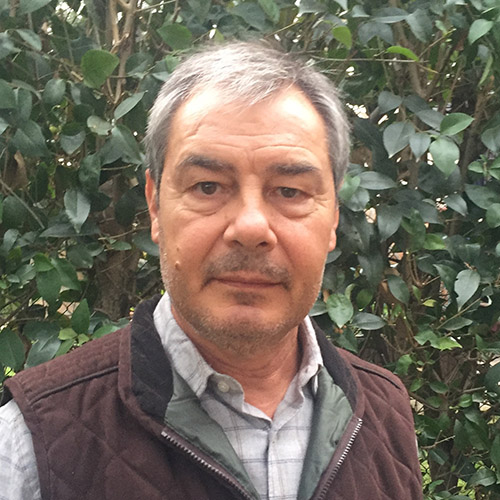People
These are the different members and collaborators of the Sabina research group:
MEMBERS

Rubén G. Mateo
With a background in Ecology and Botany, Ruben focuses his research on the integration of diverse disciplines, including spatial ecology and predictive modeling. As a result, he has contributed to the fields of biodiversity, biogeography, botany, climate change, plant conservation, ecology, community assembly, and macroecology, among others. Currently, his primary interest is to review how various drivers define the distribution of plant species and biodiversity patterns at different scales.

Juan Carlos Moreno Saiz
Juan Carlos is Professor of Botany at the Universidad Autónoma de Madrid. He is the acting president of both the Spanish Botanical Society (SEBOT) and the Spanish Society of Plant Conservation Biology (SEBiCoP). His research focuses on conservation biogeography, investigating the underlying causes of patterns of richness, endemism and floristic regions, as well as on the conservation of endemic and threatened flora, offering ecological, demographic and genetic approaches.

Miguel Ángel Rodríguez
Miguel Ángel pursues the documentation of broad-scale patterns of distribution of faunas and floras, as well as the identification of current and historical factors and processes that underlie them. He is also interested in the effects of climate change and habitat loss and fragmentation on species and biotas.

Juan Antonio Calleja
Juan Antonio’s research spans four disciplines to solve basic and applied science questions: 1) riparian plant communities (diversity and richness); 2) conservation biology of vascular and non-vascular plants and habitats included within the European Directive “Habitat”; 3) Phylogenetic, phylogenomic, and phylogeographic studies on vascular and non-vascular plants; 4) interactions between plants and animals in Mediterranean and Alpine ecosystems.

Teresa Goicolea
Teresa focuses her research on how landscape characteristics and natural and human-driven landscape changes can affect long term habitat availability, connectivity, and thus survival of species. Specifically, she develops species distribution and connectivity models that consider specific species traits and their relationship with landscapes to guide conservation and restoration measures dealing with a broad array of conservation concerns, including habitat fragmentation, land use and climate change, and the spread of invasive species.

Virgilio Gómez Rubio
Virgilio is an Assistant Professor in the Department of Mathematics at the Universidad de Castilla-La Mancha. His lines of research focus on Bayesian inference, spatial statistics and computational methods. He has published books on spatial data analysis and Bayesian inference and developed several packages for the R statistical software. He has been awarded the SEIO – Fundación BBVA 2022 award for the best contribution in Data Science and Big Data for his book on Bayesian inference with INLA.

Robinson J. Herrera-Feijoo
Robinson focuses his research on the application of ecological modeling techniques for the management and conservation of biodiversity. Along with other researchers, he explores multiple approaches to understand a certain species’ location, its distribution patterns, and its response to climate change under various future scenarios.
https://www.researchgate.net/profile/Robinson-J-Herrera-Feijoo

Jennifer Morales-Barbero
Jennifer focuses her research on unifying macroecology and macroevolution to gain a comprehensive understanding of the ecological and historical-evolutionary factors that drive the global distribution of biodiversity and species coexistence.

Javier Seoane
Javier focuses his research in identifying the linkage between the behavioral and evolutionary strategies taken by individuals and the geographical patterns of biodiversity, in order to use this knowledge for land management.

Alejandra Zarzo-Arias
Alejandra is a postdoctoral researcher (Margarita Salas) at the MNCN (CSIC) and the Universidad Autónoma de Madrid. She is a spatial ecologist and studies the effects of the environmental niche of species and their interactions on their distribution and responses to global change, applying this knowledge to conservation (particularly of mammals). She is interested in modeling populations, predicting changes and assessing extinction risk, considering different spatial scales.
COLLABORATORS

Pepa Aroca
Pepa is a technical staff member at the School of Forest Engineering and Natural Resources of the Universidad Politécnica de Madrid. Her research focuses on forest restoration. She has worked on various topics, such as habitat modelling for species selection in reforestation; the effect of site conditions and soil preparation on seedling development; and the dynamics of biodiversity in managed coniferous forests. This work provides useful answers to decision-maker and landowners.

Jaime Boyano
Jaime is a Graduate in Environmental Sciences and Geography and Territorial Planning at the Universidad Autónoma de Madrid. He is currently studying a Msc in Geographic Information Technologies at the Universidad de Alcalá de Henares. His thesis was about hierarchical ecological models of forest species in the Iberian Peninsula.

Manuel de la Estrella
Manuel is an Assistant Professor at the Universidad de Córdoba, Spain. He is an expert in Legume systematics, with a broad interest in taxonomy and evolution of plants. Throughout his career, he has obtained numerous competitive grants (e.g., CSIC BIP 2003, UCM-FPI, Juan de la Cierva, José Castillejo, Marie Skłodowska Curie), international awards (2 QCBS Award) and 6 EU SYNTHESYS grants. He has been PI of European (GLDAFRICA), international (GLDAMERICA) and national (DIVEREND) projects. His research has progressed from a purely descriptive approach to studies in biodiversity, evolution, and biogeography.
https://www.uco.es/organiza/departamentos/botanica/es/manuel-de-la-estrella-gonzalez

Enrique García-Barros
Enrique is an Assistant Professor at the Universidad Autónoma de Madrid. His teaching duties include several courses within the scope of the Zoology/Animal Biology area. His research work has concentrated on the faunistic, ecology, taxonomy, biology and biogeography of the Lepidoptera, with emphasis on the butterflies (Superfamily Papilionoidea) of the Iberian Peninsula.
Juan Ignacio García Viñas
Im PhD in the ETSI Montes, Forestry and Natural Environment of the UPM. My research work has been directed to the analysis of vegetation: vegetation mapping, species distribution models and plant communities, functional and habitat characteristics of species and plant biodiversity especially related to anthropogenic interventions.

Ricardo Garilleti
Ricardo is Professor of Botany at the Universitat de València. His research focuses primarily on two fields: 1) systematics, taxonomy and biogeography of the moss family Orthotrichaceae, and 2) Spanish woody riparian vegetation from a diversity and conservation perspective.

Aitor Gastón
Aitor is an associate professor at the School of Forest Engineering and Natural Resources of the Universidad Politécnica de Madrid (Department of Natural Systems and Resources). His main research activity consists of the development of species distribution and resource selection models for animals and plants, applied to the improvement of ecological connectivity through habitat conservation and restoration.

Sergio González-Ávila
Sergio focuses his research on landscape ecology. He has worked in projects related to landscape change and monitoring, in both Spain and Europe. In recent years, he has focused on ecological connectivity analyses, as well as large-scale forest habitat fragmentation using landscape structure indexes.

Francisco Lara
Francisco is a Professor of Botany at the Universidad Autónoma de Madrid, whose research follows two main lines: 1) the taxonomy, phylogeny, and biogeography of an important family of mosses (Orthotrichaceae), and 2) the study of the diversity, distribution, and conservation of the Spanish riparian vegetation.

Herlander Lima
Herlander is a PhD student interested in theoretical ecology and informatics. Currently, his work mainly consists of evaluating the performance of different methods in the analysis of ecological systems.

Manuel J. Macía
Manuel focuses his research on understanding the patterns, processes and mechanisms that determine the floristic composition of woody plant assemblies of Neotropical rainforests, mainly in north-western South America. He has addressed the study of eco-floristic patterns and environmental variables which explain the spatial distribution of woody plants communities, species commonness and rarity assembly processes, functional and phylogenetic diversity, and the integration with ethnobotanical studies to preserve the biocultural diversity.

Helena Romo
Helena focuses her research on the biology, biogeography, conservation and modeling of diurnal butterflies (Lepidoptera, Papilionoidea). In recent years, she has deepened on modeling the potential distribution of butterflies taking into account the influence of climate change.
https://portalcientifico.uam.es/es/ipublic/researcher/260494
Santiago Saura Martínez de Toda
Santiago Saura Martínez de Toda is a full professor in the Department of Systems and Natural Resources at the School of Forestry, Natural Resources, and Environmental Engineering of the Technical University of Madrid (UPM). He is a member of the UPM’s R&D&I Center for Biodiversity Conservation and Sustainable Development (CBDS). He has coordinated numerous national and European research projects and is the co-author of over ninety articles in international journals in fields such as landscape ecology, ecological connectivity, forest management, conservation of threatened forest species, protected natural areas, and sustainable development goals.
https://scholar.google.com/citations?hl=es&user=kOLDlZUAAAAJ

Bolier Torres
Bolier is a full professor at the Universidad Estatal Amazónica (Ecuador). His research focuses on the analysis of the structure, diversity and carbon sequestration potential of forest species and their relationship with the livelihoods of local populations, with the objective of promoting forest landscape restoration processes from ecological and productive perspectives. In this process he collaborates with a multidisciplinary team of researchers oriented to understand the factors determining deforestation and habitat fragmentation, as well as the adoption of restoration strategies at different scales and dimensions such as social, economic and participatory governance aspects.

Asunción Saldaña
Asunción focuses her research on the ecology of biological invasions, with particular interest in understanding what environmental factors determine the success of invasive species, their distribution and abundance in their native and introduced areas, and their ecological impact on ecosystem services. Her research also approaches landscape ecology, with emphasis on the quantification of changes occurring in the territory -especially in rural landscapes- using GIS and remote sensing.
ENTITIES AND PROJECTS
PARTICIPATING ENTITIES
Autonomous University of Madrid: https://www.uam.es/uam/inicio
University of Alcalá de Henares: https://www.uah.es/es/
University of Castilla-La Mancha: https://www.uclm.es
Polytechnic University of Madrid: https://www.upm.es
University of Córdoba: http://www.uco.es
University of Valencia: https://www.uv.es
Spanish Botanical Society: https://www.sebot.org
WWF Spain: https://www.wwf.es
Community of Madrid: https://www.comunidad.madrid
Regional Government of Castilla-La Mancha: https://www.castillalamancha.es
RESEARCH PROJETCS
Project Grant (NextDive; PID2021-124187NB-I00) funded by MCIN/AEI/ 10.13039/501100011033 and by “ERDF A way of making Europe”
Project Grant (Connect2restore; TED2021-129589B-I00) funded by MCIN/AEI/ 10.13039/501100011033 and by “European Union NextGenerationEU/PRTR””













